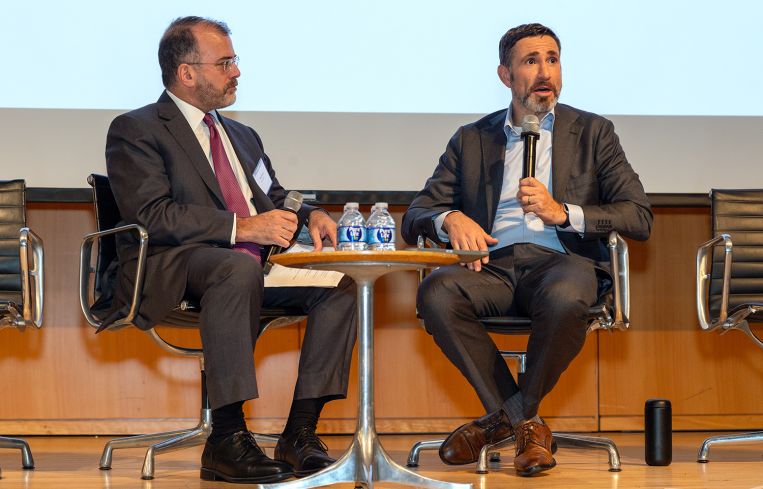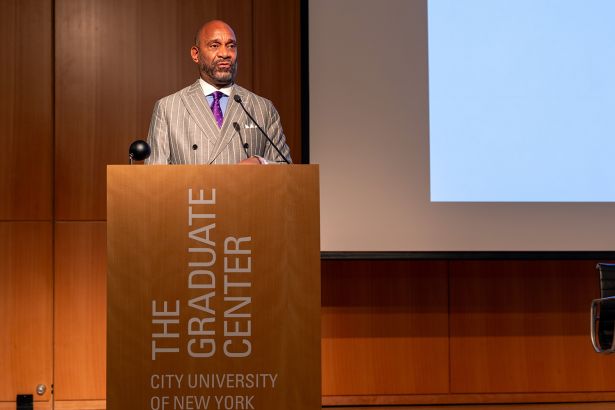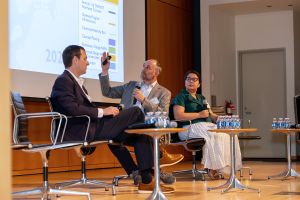MTA’s ‘Tragic’ Loss of Congestion Pricing Funds Seizes Spotlight at Projects Forum
Commercial Observer confab also covered new airport terminals and rail tunnels, but it was hard to escape the $15 billion elephant in the room
By Larry Getlen June 24, 2024 3:50 pm
reprints
At Commercial Observer’s Public Projects Forum on June 18 at the City University of New York Graduate Center, Jamie Torres-Springer, president of Metropolitan Transportation Authority Construction and Development, gave candid answers to the question currently on every New Yorker’s mind: Namely, what are the immediate implications of the MTA’s loss of billions in funding due to Gov. Kathy Hochul’s abrupt cancellation of congestion pricing?
“We’re in something of a scramble right now, honestly,” said Torres-Springer, who called the loss of the $15 billion that was expected from tolling most motorists entering central Manhattan “tragic.” Torres-Springer joked that he had originally anticipated his appearance at the forum to be a “victory lap” in celebration of the implementation of congestion pricing.
“For context, the $15 billion that was to be funded and financed through congestion pricing represents about a third of our current 2020-2024 capital program,” said Torres-Springer during a conversation with E-J Electric Installation CEO Anthony Mann. “But because we’re a couple years into that program, it’s really more like two-thirds of the dollars we have left uncommitted. We have a real problem. We’re missing $15 billion.”
Torres-Springer later clarified that the loss is actually closer to $17 billion, as the MTA will now need to “walk away from” another approximately $2 billion in federal money designated for the Second Avenue Subway since it cannot fund its share of the project. (The MTA halted construction on the Second Avenue Subway after the event.)
He said his agency is currently re-prioritizing the MTA’s capital program, though he insisted that the fate of New York City’s transit system will not revert to reminders of dire times.
“The commitment that we’ve made, that we know is important to a group like this, is that we’re not gonna go back to the days of a transit system in New York that was failing,” said Torres-Springer. “We’ve all lived through periods like that. We’re not in a period like that at present.”
Torres-Springer said that the subway system currently has its best on-time performance in over a decade, and that the commuter railroads are approaching 98 percent on-time performance.
But he did note that in going through the capital budget “line by line,” the MTA would be focusing “only on those projects that ensure safe and reliable operation of the transit system, and keeping the transit system in a state of good repair.”
He also pointed out that the total capital program had been established at $55 billion — 70 percent larger than the previous plan — but, with Hochul’s decision, it had shrunk to $38 billion, basically wiping out many anticipated improvements.
“We were investing in a lot of amazing improvements,” said Torres-Springer, noting that a station-by-station program of improved physical accessibility, re-signaling the system, improving system resiliency and system-wide communications, plus various expansion projects, are now all being placed “on the shelf.”
“We’re focused on the fundamentals of a state of good repair. Anything that isn’t critical to good repair, we’ll pull back on for the moment,” he said, specifying structures, tracks, rolling stock (the trains themselves), signals and power as the department’s priorities for the next few years.
In a panel on John F. Kennedy International Airport’s new 2.4 million-square-foot Terminal One, Ty Osbaugh, global aviation leader and principal at the architecture and design firm Gensler, noted the importance of the terminal on several fronts.
“This is one of the first terminals where there’s a mandate that it has to be a top five terminal in the world,” said Osbaugh. “This is a gateway to New York City, New York state, and the U.S. So for us, it’s really about, if I’ve never been here before, what is that moment of surprise and delight that will make me remember this terminal.”
From a convenience and operations standpoint, the terminal will use only biometric processes.
“This will be one of the first terminals where there won’t be any transactions,” said Osbaugh. “We’re trying to make it as seamless as possible until you get to your gate.”
Hersh Parekh, deputy chief of intergovernmental affairs for the Port Authority of New York and New Jersey, said that the entire JFK terminal program broke a New York state record for participation by minority- and women-owned business enterprises (MWBEs), with over $2.3 billion awarded to MWBEs.
Others on the panel included Quentin Brathwaite, senior vice president at design and construction firm McKissack & McKissack; Anthony Pastore, senior vice president at construction company AECOM Tishman; and moderator Walter Mehl, managing partner at mechanical engineering firm Jaros Baum & Bolles.

Event attendees also heard from emcee Fuquan Collins, chief diversity officer at Turner Construction Company; opening keynote speaker Michael Garner, chief business diversity officer at the New York Mayor’s Office of Minority & Women-Owned Business Enterprises; Lisa Bova-Hiatt, CEO of New York City Housing Authority; and Doron Netanel, CFO at electrical contractor Electra USA; and Alison Landry, chief infrastructure officer at the Office of the Deputy Mayor of Operations.
Landry, interviewed by Louis Coletti, senior adviser at Davidoff Hutcher & Citron, spoke about the city’s public/private Capital Process Reform Task Force, which she said is handling “bread and butter issues” across New York, including increasing all-important public restroom availability and other public facilities.
“This is an initiative to say let’s really look at why these projects are so difficult to get done. How can we get out of our own way to getting things done?,” said Landry, invoking solutions from partnering with industry to ensuring the hiring of the right talent.
A panel looking at the redevelopment of Willets Point, Queens, featured Frank Monterisi, executive vice president at developer Related Companies; Paul “PJ” Berg, executive vice president of real estate transaction services at the New York City Economic Development Corporation; and moderator Michele O’Connor, senior principal at engineering firm Langan.
“How many places in New York do you find 60 acres of untapped development potential? There’s not many of them,” said Monterisi. “We’re gonna [take] this place that really didn’t make a lot of sense and build a ton of housing, all of it affordable; we’re gonna build a soccer stadium for the New York City Football Club, a hotel and retail. It’s gonna be great.”
Attendees also heard a discussion of the ongoing Gateway Project, which includes a new Hudson River rail tunnel, with Craig Schulz, director of communications and external affairs with Amtrak; Stephen Sigmund, executive director of the global gateway alliance, a group started to address infrastructure challenges in the New York area; and moderator Sheila Pozon, land use special counsel at Kramer Levin Naftalis & Frankel.

Schulz noted that the project’s first phase was dedicated to “eliminating failure.”
“Phase 1 is about eliminating what we call these single points of failure,” said Schulz. “The existing Portal Bridge [in New Jersey] is 23 feet over the river. It fails to close properly. It’s called the Achilles heel of the Northeast Corridor — it’s a terrible location. So eliminating that movable span and making it a much higher clearance, fixed bridge will eliminate that single point of failure.”
Other panels included a review of the impact of design-build on the city’s outer borough-centered jail projects, with Steve Alessio, CEO and president at construction firm the Sweet Group; Eduardo Del Valle, deputy commissioner of the Department of Design and Construction; Scott Demel, partner at architecture firm Marvel; Joshua Frankel, director of design-build at Hunter Roberts Construction Group; and moderator Greg Faulkner, partner at Robinson + Cole.
And a discussion among Port Authority officials about the revitalization of New York and New Jersey infrastructure with Luke Bassis, director of procurement; Tobi Mettle, deputy chief at the office of diversity, equity and inclusion; Lindsay Degueldre, chief of project delivery; and Jacquelene McCarthy, director of aviation redevelopment.
Larry Getlen can be reached at lgetlen@commercialobserver.com.



